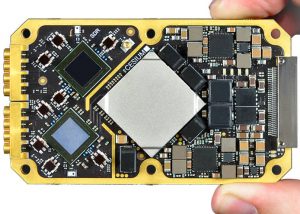
Called the SDR-1001 (cover removed right), and tested to NASA GEVS standards, it has four transmit and four receive channels tunable from 300MHz to 6GHz. Bandwidth is 100MHz per channel.
At the heart is an FPGA “with 70% resources available for custom designs”, according to the company.
By default it ships with a pre-loaded CSMA (carrier sense multiple access) mesh networking reference modem with SpaceWire and Ethernet connectivity.
“When two SDRs establish a connection, data packets from Ethernet, SpaceWire or serial port are routed across the link,” said the company. “Cesium is also developing turn-key waveform support for DVB-S2, DVB-S2X and CCSDS with Tx data rates up to 500Mbit/s.”
An associated FPGA development kit allows custom waveforms to be built and deployed on the FPGA, with the underlying BSP (board support package) firmware providing an API for controlling the RF front end and data management, and enabling access to baseband IQ data. The kit also includes support and training.
Size is 50 x 84 x 13mm, with 100g mass
Redundancy and fail-over logic is integrated to provide resiliency from radiation events, with on-board telemetry delivering system health and power management information.
Its ruggedness and programmability suit it to low-earth missions of five to seven years duration, said Cesium.
Although offered as a stand-alone module, the device can be used with other products in Cesium’s modular range including integrated L-Band, S-Band, X-Band, Ku-Band and Ka-Band connectivity and phased array units.
The company is headquartered in Austin, Texas, and has offices in Broomfield, Colorado.
The SDR-1001 product page is here